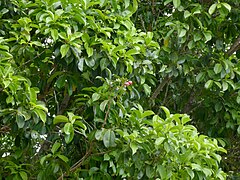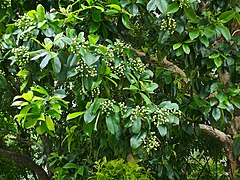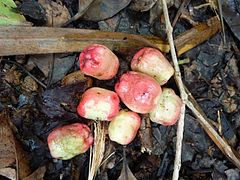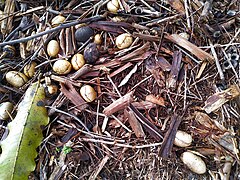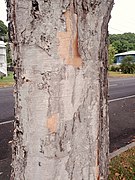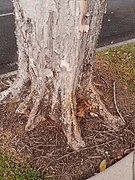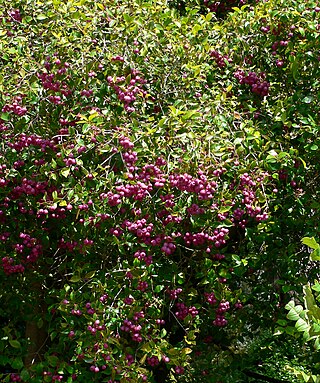
Syzygium smithii is a summer-flowering, winter-fruiting evergreen tree, native to Australia and belonging to the myrtle family Myrtaceae. It shares the common name "lilly pilly" with several other plants.It is planted as shrubs or hedgerows, and features: rough, woody bark; cream and green smooth, waxy leaves; flushes of pink new growth; and white to maroon edible berries. Unpruned, it will grow about 3–5 m (9.8–16.4 ft) tall in the garden.

Pleiogynium timoriense, commonly known as the Burdekin plum, sweet plum, tulip plum, or in the Djabugay language guybalum, is a medium-sized fruit-bearing tree in the cashew and mango family Anacardiaceae native to Malesia, Australia and the Pacific Islands.
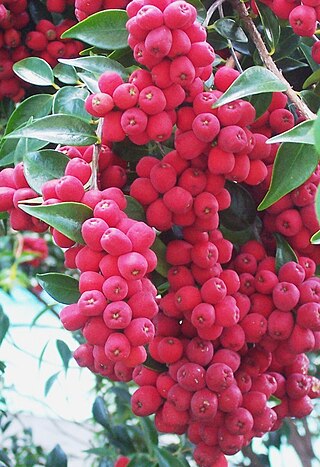
Syzygium luehmannii is a medium-sized coastal rainforest tree native to Australia. Common names include riberry, small leaved lilly pilly, cherry satinash, cherry alder, or clove lilli pilli.

Euroschinus falcatus is a large tree in the mango and cashew family Anacardiaceae, found along almost the entire east coast of Australia from Cape York Peninsula to Jervis Bay. Common names include blush cudgerie and maiden's blush.

Syzygium hemilamprum, commonly known as the broad-leaved lilly pilly, blush satinash, cassowary gum, Eungella gum, and treated as Acmena hemilampra in New South Wales and Queensland, is a species of flowering plant in the family Myrtaceae and is native to New South Wales, Queensland and the Northern Territory. It is a rainforest tree with broadly lance-shaped to elliptic leaves, panicles of white flowers and more or less spherical white fruit.

Atractocarpus chartaceus, commonly known as the narrow-leaved gardenia, is a species of evergreen flowering plant in the madder and coffee family Rubiaceae. It is mostly found in subtropical rainforest of eastern Australia, and it is cultivated for its fragrant flowers and colourful fruit.

Atractocarpus fitzalanii, commonly known as the brown gardenia or yellow mangosteen, is a species of plant in the coffee and madder family Rubiaceae. It is found in coastal parts of tropical Queensland, Australia. The beautifully scented flowers and glossy foliage has seen this plant enter cultivation in gardens of eastern Australia.

Didymocheton pettigrewianus, commonly known as spur mahogany, spurwood, or Cairns satinwood, is a large tree in the family Meliaceae. It is native to the rainforests of Malesia, Papuasia and Queensland. In Queensland it occurs only in a small part of the northeast coast.

Syzygium cormiflorum, commonly known as the bumpy satinash, is a species of Syzygium tree endemic to Queensland in northeastern Australia.

Carnarvonia araliifolia, commonly known as the red oak, red silky oak, Caledonian oak or elephant's foot, is the sole species in the monotypic genus Carnarvonia, a member of the Proteaceae plant family. It is endemic to the rainforests of northeastern Queensland.

Didymocheton gaudichaudianus, commonly known as ivory mahogany, is a species of rainforest tree in the family Meliaceae, native to Malesia, Papuasia, Queensland, and some southwest Pacific islands.

Syzygium angophoroides, commonly known as bark in wood, Yarrabah satinash, or swamp satinash, is a tree of the family Myrtaceae native to Western Australia, the Northern Territory and Queensland in Australia. It typically grows to a height of 6 to 35 metres. It blooms between July and November producing cream flowers.

Syzygium forte, commonly known as flaky-barked satinash, white apple or brown satinash, is a tree in the family Myrtaceae native to New Guinea and northern Australia.

Palaquium galactoxylum, commonly known as Cairns pencil cedar, Daintree maple or red silkwood, is a species of plants in the star apple family Sapotaceae which is endemic to rainforests of New Guinea and northern Australia. It can produce spectacularly large buttress roots.
Syzygium apodophyllum is a tree in the Myrtaceae family endemic to north Queensland. The fruit is edible. It is a host for the exotic plant-pathogen fungus Austropuccinia psidii, which is causing a lot of damage to vegetation communities and economic plants.

Syzygium unipunctatum, commonly known as the rolypoly satinash, is a small tree in the family Myrtaceae. It is endemic to the rainforests of the Wet Tropics of Queensland.
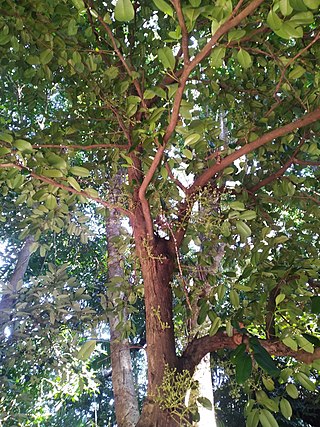
Syzygium branderhorstii, commonly known as the Lockerbie satinash, is a small tree in the family Myrtaceae found in New Guinea, the Bismarck Archipelago, Solomon Islands, Santa Cruz Islands, and northern Queensland, Australia. It is cauliflorous, producing large inflorescences from the trunk. The fruits are eaten by brush turkeys.
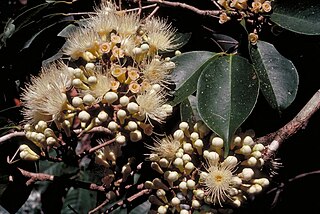
Syzygium sayeri, commonly known as pink satinash, is a plant in the family Myrtaceae which is native to northeastern Queensland, Australia, and New Guinea.

Syzygium puberulum, commonly known as white satinash or downy satinash, is a plant in the family Myrtaceae which is native to rainforests of Cape York Peninsula, Queensland, and Papua New Guinea. It was first described in 1942.

Diploglottis bernieana, commonly known as Bernie's tamarind or large leaf tamarind, is a plant in the maple and lychee family Sapindaceae. It was first described in 1987 by the Australian botanist Sally T. Reynolds and is found only the Wet Tropics region of northeastern Queensland, Australia.



